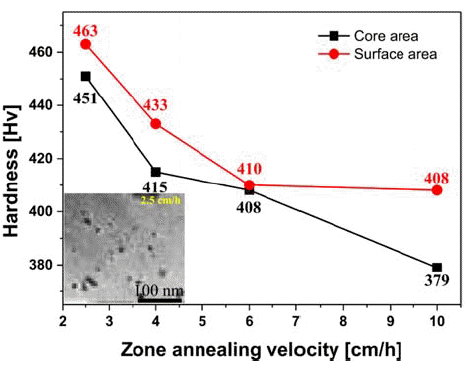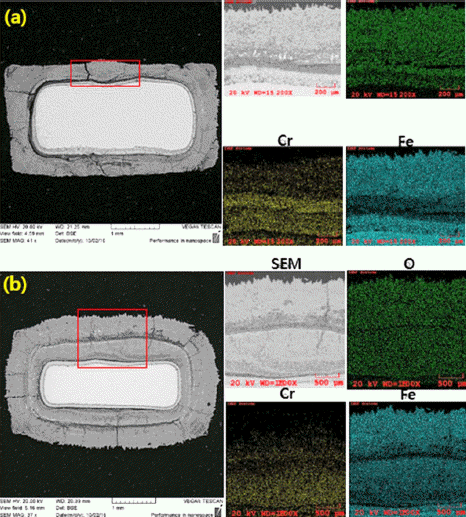- [Korean]
- Effect of Zone Annealing Velocity on the directional Recrystallization in a Ni base Oxide Dispersion Strengthened Alloys
-
Young-Kyun Kim, Seong-June Yoon, Jong-Kwan Park, Hwi-Jun Kim, Man-Sik Kong, Kee-Ahn Lee
-
J Korean Powder Metall Inst. 2018;25(4):331-335. Published online August 1, 2018
-
DOI: https://doi.org/10.4150/KPMI.2018.25.4.331
-
-
507
View
-
2
Download
-
1
Citations
-
 Abstract Abstract
 PDF PDF
This study investigates the directional recrystallization behavior of Ni based oxide dispersion strengthened (ODS) alloy according to the zone annealing velocity. The zone annealing temperature is set as 1390°C, while the zone velocities are set as 2.5, 4, 6, and 10 cm/h, respectively. The initial microstructure observation of the as-extruded sample shows equiaxed grains of random orientation, with an average grain size of 530 nm. On the other hand, the zone annealed samples show a large deviation in grain size depending on the zone velocities. In particular, grains with a size of several millimeters are observed at 2.5-cm/h zone velocity. It is also found that the preferred orientation varies with the zone annealing velocity. On the basis of these results, this study discusses the role of zone velocities in the directional recrystallization of Ni base ODS alloy. -
Citations
Citations to this article as recorded by  - Directional recrystallisation processing: a review
Chao Yang, Ian Baker
International Materials Reviews.2021; 66(4): 256. CrossRef
- [Korean]
- High Temperature Oxidation Behavior of Fe-14Cr Ferritic Oxide Dispersion Strengthened Steels Manufactured by Mechanical Alloying Process
-
Young-Kyun Kim, Jong-Kwan Park, Hwi-Jun Kim, Man-Sik Kong, Kee-Ahn Lee
-
J Korean Powder Metall Inst. 2017;24(2):133-140. Published online April 1, 2017
-
DOI: https://doi.org/10.4150/KPMI.2017.24.2.133
-
-
517
View
-
5
Download
-
1
Citations
-
 Abstract Abstract
 PDF PDF
This study investigates the oxidation properties of Fe-14Cr ferritic oxide-dispersion-strengthened (ODS) steel at various high temperatures (900, 1000, and 1100°C for 24 h). The initial microstructure shows that no clear structural change occurs even under high-temperature heat treatment, and the average measured grain size is 0.4 and 1.1 μm for the as-fabricated and heat-treated specimens, respectively. Y–Ti–O nanoclusters 10–50 nm in size are observed. High-temperature oxidation results show that the weight increases by 0.27 and 0.29 mg/cm2 for the asfabricated and heat-treated (900°C) specimens, and by 0.47 and 0.50 mg/cm2 for the as-fabricated and heat-treated (1000°C) specimens, respectively. Further, after 24 h oxidation tests, the weight increases by 56.50 and 100.60 mg/cm2 for the as-fabricated and heat-treated (1100°C) specimens, respectively; the latter increase is approximately 100 times higher than that at 1000°C. Observation of the surface after the oxidation test shows that Cr2O3 is the main oxide on a specimen tested at 1000°C, whereas Fe2O3 and Fe3O4 phases also form on a specimen tested at 1100°C, where the weight increases rapidly. The high-temperature oxidation behavior of Fe-14Cr ODS steel is confirmed to be dominated by changes in the Cr2O3 layer and generation of Fe-based oxides through evaporation. -
Citations
Citations to this article as recorded by  - Microstructure and Wear Properties of Oxide Dispersion Strengthened Steel Powder Added Steel-Based Composite Material for Automotive Part
Young-Kyun Kim, Jong-Kwan Park, Kee-Ahn Lee
journal of Korean Powder Metallurgy Institute.2018; 25(1): 36. CrossRef
- [Korean]
- The Effects of MoS2 Addition on the Mechanical Properties of Fe-Cr-Mn-C-V P/M Alloy
-
Geon-Hong Kim, Hyun Seok Yang, Man-Sik Kong
-
J Korean Powder Metall Inst. 2014;21(4):294-300. Published online August 1, 2014
-
DOI: https://doi.org/10.4150/KPMI.2014.21.4.294
-
-
 Abstract Abstract
 PDF PDF
The connecting rod is one of the most important parts in automotive engines, transforming the reciprocal motion of a piston generated by internal combustion into the rotational motion of a crankshaft. Recent advances in high performance automobile engines demand corresponding technological breakthroughs in the materials for engine parts. In the present research, the powder metallurgy (P/M) process was used to replace conventional quenching and/or tempering processes for mass production and ultimately for more cost-efficient manufacturing of high strength connecting rods. The development of P/M alloy powder was undertaken not only to achieve the improvement in mechanical properties, but also to enhance the machinability of the P/M processed connecting rods. Specifically MoS2 powders were added as lubricants to non-normalizing Fe-Cr-Mn-V-C alloy powder to improve the post-sintering machinability. The effects of MoS2 addition on the microstructure, mechanical properties, and machining characteristics were investigated.
|





